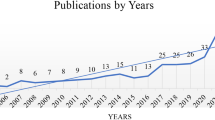Abstract
Biomimicry, the novel field of discipline which studies and emulates nature’s models to solve human challenges in a sustainable way is gradually becoming a global phenomenon. However, the paradigm is still in its infancy in the construction industry compared to other sectors. Despite its potential in providing outstanding innovative solutions, the adoption and implementation are impeded by several factors. This research sets out to address and establish the benefits of embracing biomimicry in the construction industry. A structured questionnaire survey was conducted with biomimicry practitioners and construction professionals as respondents. A quantitative approach to data analysis was employed using the mean scores of the factors identified. Creation of green market and services, protection of biodiversity, and conservation of natural resources are the top three benefits established. This systematic approach towards understanding the taxonomy of the benefits of biomimicry is imperative for aiding and reinforcing sustainable construction practices in the industry.
Access this chapter
Tax calculation will be finalised at checkout
Purchases are for personal use only
Similar content being viewed by others
References
Moavenzadeh, F.: Global Construction and the Environment: Strategies and Opportunities. Wiley, Hoboken (1994)
Giang, D.T., Pheng, L.S.: Role of construction in economic development: review of key concepts in the past 40 years. Habitat Int. 35(1), 118–125 (2011)
Shi, L., Ye, K., Lu, W., Hu, X.: Improving the competence of construction management consultants to underpin sustainable construction in China. Habitat Int. 41, 236–242 (2014)
Ramsaran, R., Hosein, R.: Growth, employment and the construction industry in Trinidad and Tobago. Constr. Manag. Econ. 24(5), 465–474 (2006)
Wang, N.: The role of the construction industry in China’s sustainable urban development. Habitat Int. 44, 442–450 (2014)
Pearce, A., Ahn, Y.H.: Sustainable Buildings and Infrastructure: Paths to the Future. Routledge, Abingdon (2012)
Benyus, J.M.: A biomimicry primer. The Biomimicry Institute and the Biomimicry Guild (2011)
Rao, R.: Biomimicry in architecture. Int. J. Adv. Res. Civil, Struct. Environ. Infrastruct. Eng. Dev. 1(3), 101–107 (2014)
Murr, L.E.: Biomimetics and biologically inspired materials. In: Handbook of Materials Structures, Properties, Processing and Performance, pp. 521–552. Springer (2015)
Vincent, J.F., Bogatyreva, O.A., Bogatyrev, N.R., Bowyer, A., Pahl, A.K.: Biomimetics: its practice and theory. J. Roy. Soc. Interface/Roy. Soc. 3(9), 471–482 (2006)
El Din, N.N., Abdou, A., El Gawad, I.A.: Biomimetic potentials for building envelope adaptation in Egypt. Procedia Environ. Sci. 34, 375–386 (2016)
Merrill, C.L.: Biomimicry of the Dioxygen Active Site in the Copper Proteins Hemocyanin and Cytochrome Oxidase: Part I: Copper (I) Complexes Which React Reversibly with Dioxygen and Serve to Mimic the Active Site Function of Hemocyanin. Part II: Mu-Imidazolato Binuclear Metalloporphyrin Complexes of Iron and Copper as Models for the Active Site Structure in Cytochrome Oxidase, Doctoral dissertation, Rice University (1982)
Goss, J.: Biomimicry: Looking to Nature for Design Solutions. Corcoran College of Art and Design. ProQuest Dissertations Publishing, Ann Arbor (2009)
Benyus, J.M.: Biomimicry: Innovation Inspired by Nature. William Morrow & Company, New York (1997)
Hargroves, K., Smith, M.: Innovation inspired by nature: biomimicry. Ecos 2006(129), 27–29 (2006)
Strategic Direction.: Nature's inspiration: solving sustainability challenges. Strateg. Dir. 24(9), 33–35 (2008)
Nychka, J.A., Chen, P.: Nature as inspiration in materials science and engineering. JOM J. Miner. Metals Mater. Soc. 64(4), 446–448 (2012)
Rinaldi, A.: Naturally better. Science and technology are looking to nature’s successful designs for inspiration. EMBO Rep. 8(11), 995–999 (2007)
Ask Nature: Biomimicry taxonomy. The Biomimicry Institute. https://asknature.org/resource/biomimicry-taxonomy/
Shu, L., Ueda, K., Chiu, I., Cheong, H.: Biologically inspired design. CIRP Ann. – Manuf. Technol. 60(2), 673–693 (2011)
Gamage, A., Hyde, R.: A model based on biomimicry to enhance ecologically sustainable design. Archit. Sci. Rev. 55(3), 224–235 (2012)
Aziz, M.S., El Sherif, A.Y.: Biomimicry as an approach for bio-inspired structure with the aid of computation. Alexandria Eng. J. 55, 707–714 (2015)
Pronk, A., Blacha, M., Bots, A.: Nature’s experiences for building technology. In: Proceedings of the 6th International Seminar of the International Association for Shell and Spatial Structures (IASS) Working Group (2008)
De Pauw, I., Kandachar, P., Karana, E., Peck, D., Wever, R.: Nature inspired design: strategies towards sustainability. In: Knowledge Collaboration & Learning for Sustainable Innovation: 14th European Roundtable on Sustainable Consumption and Production (ERSCP) Conference and the 6th Environmental Management for Sustainable Universities (EMSU) Conference, Delft, The Netherlands, 25–29 October, Delft University of Technology, The Hague University of Applied Sciences, TNO (2010)
Arnarson, P.O.: Biomimicry: New Technology. Reykjavík University. http://olafurandri.com/nyti/papers2011/Biomimicry%20-%20P%C3%A9tur%20%C3%96rn%20Arnarson.pdf
Badarnah, L., Kadri, U.: A methodology for the generation of biomimetic design concepts. Archit. Sci. Rev. 58(2), 120–133 (2015)
Field, A.: Discovering Statistics Using IBM SPSS Statistics. Sage Publications, Thousand Oaks (2013)
Polit J., David C.: Regreening nature: turning negative externalities into opportunities, Master’s thesis, Delft/Delft University of Technology (2014)
Kennedy, E., Fecheyr-Lippens, D., Hsiung, B., Niewiarowski, P.H., Kolodziej, M.: Biomimicry: a path to sustainable innovation. Des. Issues 31(3), 66–73 (2015)
Klein, L.: A phenomenological interpretation of biomimicry and its potential value for sustainable design, Doctoral dissertation, Kansas State University (2009)
Zari, M.P.: Biomimetic design for climate change adaptation and mitigation. Archit. Sci. Rev. 53(2), 172–183 (2010)
Acknowledgments
The University of Johannesburg is acknowledged for providing the Global Excellence Stature Scholarship through the Postgraduate School. The authors also wish to acknowledge the participants who responded to the survey.
Author information
Authors and Affiliations
Corresponding author
Editor information
Editors and Affiliations
Rights and permissions
Copyright information
© 2019 Springer International Publishing AG, part of Springer Nature
About this paper
Cite this paper
Oguntona, O.A., Aigbavboa, C.O. (2019). Benefits of Biomimicry Adoption and Implementation in the Construction Industry. In: Charytonowicz, J., Falcão, C. (eds) Advances in Human Factors, Sustainable Urban Planning and Infrastructure. AHFE 2018. Advances in Intelligent Systems and Computing, vol 788. Springer, Cham. https://doi.org/10.1007/978-3-319-94199-8_49
Download citation
DOI: https://doi.org/10.1007/978-3-319-94199-8_49
Published:
Publisher Name: Springer, Cham
Print ISBN: 978-3-319-94198-1
Online ISBN: 978-3-319-94199-8
eBook Packages: EngineeringEngineering (R0)




